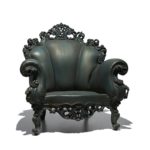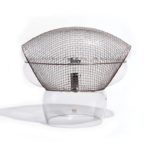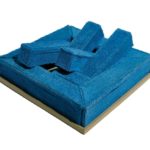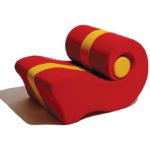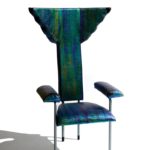Subscribe to Our Newsletter
Disruptive Design
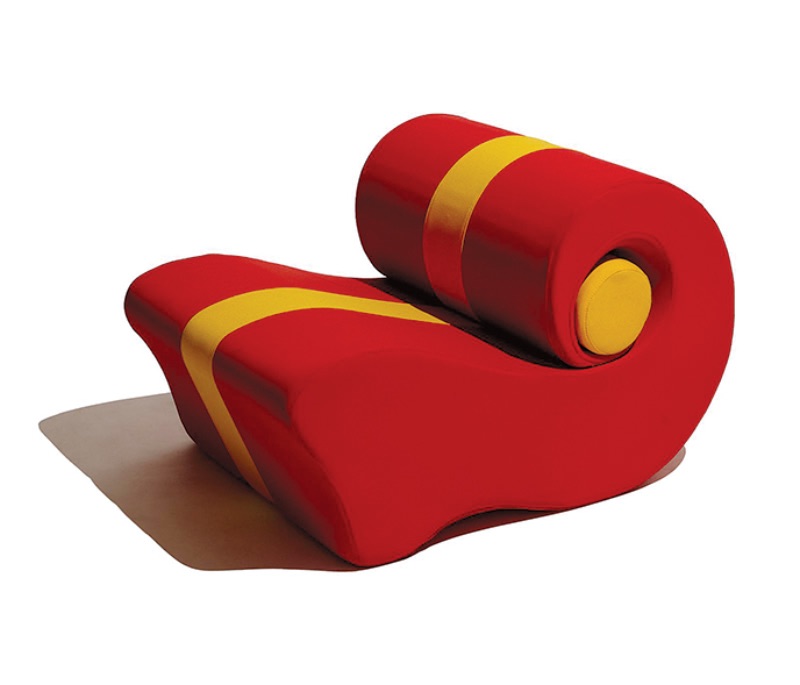
For the creators of Radical Italian Design, form didn’t have to follow function, and the only limits on what could be built were those of the imagination itself.
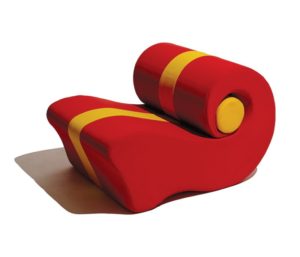
Studio65, “Chiocciola” Chair, designed 1972, made 1973, polyurethane foam and upholstery.
- Alessandro Mendini, for Studio Alchimia, manufactured by Zabro/Zanotta, Celidonia Armchair, designed 1978, made 1984–87, wood, cotton, and paint.
- Gae Aulenti, manufactured by Artemide, Patroclo Table Lamp, designed 1975, glass, steel mesh, and bulb
- Gianni Pettena, “Rumble” Model, 1967, foam, terrycloth, and cardboard.
- Studio65, “Chiocciola” Chair, designed 1972, made 1973, polyurethane foam and upholstery.
- Ugo La Pietra, “Poltroncina” Chair, 1982, tubular steel, paint, foam, and textile.
If the origin story of “Radical: Italian Design 1965–1985, The Dennis Freedman Collection,” an exhibition opening at the Museum of Fine Arts, Houston on February 14, were a light-hearted comedy, a dinner honoring Italian design luminary Ettore Sottsass would supply the meet-cute. It was at such a dinner at New York’s Friedman Benda Gallery in September 2015 that Dennis Freedman and Cindi Strauss, our protagonists, were introduced. Freedman, the former creative director of W magazine and Barneys New York, has been passionately assembling one of the best collections of Italian Radical Design in the world since the late ’90s. Strauss, the Sara and Bill Morgan curator of decorative arts, craft, and design at the MFAH, grew up around Italian design and its Radical counterpart and has been slowly amassing an important collection for the Houston institution. They talked about the postwar Italian design movement and Freedman’s collection, immediately bonding. “It became clear to me,” says Freedman, “that it was Cindi who would be the one, if anyone, to put together a major retrospective of these pieces.”
A year or so later, when Strauss was in New York, the two met up again and resumed their conversation, which lasted for hours. “At the end of that day,” says Strauss, “Dennis said, ‘You know, I’d love to work with you on something.’” After Strauss flew back to Houston, she met with Gary Tineterow, the MFAH’s director, and a full commitment was made. “Together we decided to embark on an exhibition, catalogue, and a significant part of the collection coming to Houston,” says Strauss.
“Radical” includes nearly 70 pieces of furniture, lighting, architectural models, paintings, and objects. On view are rare prototypes, one-of-a-kind, and limited-edition works by Sottsass, Archizoom Associati, Lapo Binazzi, Ugo La Pietra, Alessandro Mendini, Gianni Pettena, Studio Alchimia, and Superstudio, among others. Freedman lent about a dozen pieces to the exhibition, but the lion’s share are either gifts from the collector or acquisitions made by the museum from his collection. In other words, the MFAH now boasts the most significant collection of Italian Radical Design of any U.S. institution. Globally, their newly formed cache is rivaled only by that of the Centre Pompidou in Paris.
There is an inextricable link between Italian Radical Design and the socio-political circumstances of Italy in the wake of World War II. Experiencing a so-called “Economic Miracle” that stretched through the 1950s and into the ’60s, the country saw massive industrialization and urbanization. As a result, architecture became Italy’s most popular college major. Strauss says, “There were a lot of smart young people going to architecture school and thinking about what the new city could be—not just building and new urbanism, but how people would live and furnish their lives.”
As the 1960s wore on, labor issues and a crisis of affordable housing became pock marks on the face of Italy’s prosperity. Harnessing a deeply felt sense of political protest, the young architects and designers in the universities began to develop radical solutions to contemporary problems. But rather than taking the form of costly building projects, the outpouring of outré creativity put forth by these designers took the form of drawings and photomontages, performances, theoretical environments and models, and objects. Rethinking the notion of an architectural group, in which each member performs a separate duty, Radical collectives emerged, in which each member collaborated on projects in an equal, holistic manner.
Germano Celant, the celebrated Italian critic (and a contributor to the MFAH’s exhibition catalogue) who was to Arte Povera what Clement Greenberg was to Ab-Ex, coined the term “Italian Radical Design.” He said that these designers sought to “disrupt the significances of thing’s use” and create “practically perverse and senseless” objects, effectively developing a new vocabulary and role for modern design. As Freedman puts it, “It was the first period in design history that was not concerned about the shape of a leg.” For these designers, the expression of an idea and an object’s ability to communicate it superseded function.
Italian Radical Design, however, wasn’t alienated from the artistic output that shaped the late 1960s and ’70s. Many designers took part or found inspiration in concurrent avant-garde movements. Radical Design shared with Arte Povera a sense of equality among objects and the use of “poor” or mass-produced materials; with Pop Art a provocation of consumerism and a sense of communication through objects; with Minimalism form and the elimination of the unnecessary; and with Conceptual Art the sense of idea or concept being of fundamental importance.
If the story of the MFAH’s exhibition were an action adventure, an early edition Capitello by Studio65 would be the MacGuffin. Freedman spotted the piece in a catalogue for a design auction at Christie’s South Kensington in June 1998. It was among several other works of Italian Radical Design, all of which, as Freedman recalls, were accessibly priced. “At the time, I was an assistant art director at a magazine on a very limited budget, but, being aware of their importance in the history of design, I knew these pieces were incredibly undervalued,” he says. Resolved to acquire one, Freedman set his focus on the Capitello, a seat that takes the form of an overturned ionic column capital. Its marketing slogan was “to sit on the past”—a cheeky nod to ancient architecture and a reminder of how disruptive this new crop of architects aimed to be.
Studio65, a Turin-based architecture collective designed the piece in 1971, and Gufram©, an Italian manufacturer that created some of postwar Italy’s most avant-garde furniture, fabricated a small run from 1972 to 1978. Gufram© made the Capitello out of innovative, flexible plastics: polyurethane foam and Guflac, a pliable skin-like varnish, materials that would have a massive influence on the production of Radical Design pieces. “It was in extraordinarily good condition,” says Freedman. “It also had a really exquisite patina, something that these early-run polyurethane pieces acquire over a number of years.”
Freedman’s acquisition of the Capitello would sculpt the next two decades of his life. He brought it home to his Manhattan apartment, a postwar high-rise with neither a large freight elevator nor a front door with a wide berth. “I wasn’t even sure I could get it into my apartment,” Freedman recalls. Fortunately, he did, though it took up half of his bedroom. For Freedman, who had pored over images of Italian Radical Design in magazines like Domus and Casabella and studied the catalogue of MoMA’s seminal 1972 survey “Italy: The New Domestic Landscape” (a show that included more conventional pieces as well as radical ones), it was his first time actually living with a piece of the work he so admired. “I became obsessed with the possibility of building a collection,” he says, “but not for decoration; it was always curatorial for me.”
Freedman, recognizing that the movement wasn’t on the radar of major museums at the time, set out to amass a scholarly collection. He turned first to Simon Andrews, who was curating the sales at Christie’s South Kensington. “He was the expert who was committed to this period,” says Freedman. “In the beginning almost all of my purchases were organized by Simon.” Freedman began buying through other auction houses in Europe, typically remotely. “I was never able to go to the previews, but I would get every catalogue and felt very comfortable buying from imagery.” Freedman was also able to acquire a wide range of important pieces because he wasn’t a perfectionist about condition. “The importance of these pieces is that they were used, and if they were used, they don’t come 30 years later in perfect condition—nor should they,” says the collector.
When discussing his collection, Freedman underscores the importance of research and building a library. “For me, from the start I felt like part archeologist, part curator, part collector, because building the collection took a lot of uncovering.” The internet not being in the late ’90s and early 2000s what it is today, Freedman relied on books and relationships with dealers both big and small to find and investigate niche pieces. “I became knowledgeable, which led to many purchases where the gallery wasn’t necessarily aware of what a piece was, but I was.” Combing bookstores throughout Europe, Freedman also stayed on the lookout for books by designers themselves. “Finding a book—usually rare—is as important as finding a piece.”
It was through his research that Freedman discovered what would serve as the exhibition’s installation: an unrealized pavilion designed by Florence-based collective Archizoom for the 1969 project No-Stop City. “I came across this model that was never built, and all the bells went off,” says Freedman. Archizoom’s pavilion is an infinity room divided by a grid of columns and designed to be made of stainless steel and mirrors. The notion of imposing a grid on cities as a way to create utopia through design was essential to Archizoom’s message. “Of course, this utopian world never materialized,” says Freendman, “but that dream—the audacity of it—has always been important to me.” For the MFAH’s show, Freedman engaged Brooklyn’s Almost Studio to bring the pavilion to life in the galleries. The result is an environment for the show’s objects that simultaneously shapes the viewer’s experience and limits restrictions. “You can move through the pavilion in multiple ways–they’re not one pathway,” says Strauss. “You can go through it chronologically or enter at the end, beginning, or middle, or just enjoy the sheer aesthetics.”
Strauss notes that the show has multiple thematic sections, dedicated to the influence of Arte Povera, Pop Art, and Minimalism, the rise of the collection, and material and technological explorations. One section focuses on Radical Design’s three main geographical regions: Florence, Turin, and Milan. Though the Radicals all shared common motivation, regionalism, which has long been a part of Italy’s artistic history, played a large role in the movement.
The University of Florence became a hub for conceptual ideas and design theory. Collectives like Archizoom, Superstudio, UFO, and architect Gianni Pettena emerged in Florence as leaders of the movement, and “Superarchitecttura,” the first Radical exhibition, was held in nearby Pistoia in 1966. One seminal Florentine piece with pride of place in the MFAH’s exhibition is UFO’s Paramount Lamp (1969, made circa 1972–73). The iconic piece features a ceramic base shaped like a mountain with an umbrella-like shade under which two bulbs dangle. The mountain was an important symbol to UFO, but it was also the image on the logo of Paramount Pictures. In an interview in the exhibition’s catalogue, Lapo Binazzi, the piece’s designer, describes Paramount as “the American movie studio that makes dreams come true.” This lamp along with UFO’s aluminum and enamel “MGM” Table Lamp (designed in 1969, made circa 1975), he says, “represent an attempt to appropriate those dreams through the use and transformation of film houses’ logos.”
Milan was the locus of design journals such as Domus, Casabella, Moda, and In. At these publications, architect-editors including Alessangro Mendini, Ugo La Pietra, and Franco Raggi made manifest the Radicals’ concerns and visual vocabulary, connecting designers, architects, and artists from different corners of the avant-garde. Mendini is well represented in the exhibition. His Monumentino da Casa (1974, wood and formica), a standout of the show, borrowed the visual language of Minimalism and united the forms of a staircase and chair into a piece that is both grand and ironically reductive. In the late 1970s Mendini began working with Studio Alchimia, a Milan-based precursor to design juggernaut Memphis, which was formed in 1978. Several of his works with the collective, like Celidonia Armchair (designed 1978, made 1984–87) and the “Spaziale” Chair (1981) are in the Houston show. On view also is Sottsass’ “Capodanno” Table Lamp, a piece from the group’s significant bau. haus exhibition, which was held in Milan in 1979. The striking piece is made of brass, Formica, and neon tube.
Turin, a city revolutionized by post-war industrialization, was a center of manufacturing and material innovation. Piero Gilardi, a Turin-based designer and artist associated with Arte Povera, was an early adopter of polyurethane foam and was instrumental in developing polyurethane skin with Gufram©. Perennially inspired by nature, he created his Sassi seating system (1968)—which takes the form of naturalistic rocks—using these materials. Studio65 created the aforementioned Capitello out of these materials. Their “Chiocciola” Chair, which was designed in 1972 and made in 1973 of polyurethane foam and upholstery, takes the form of a stylized acanthus leaf. It too will be on display in Houston.
—
By Sarah E. Fensom

